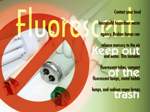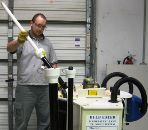
A Bulb Crushing Victory
- By Aaron Griffith
- Feb 17, 2010
Switching to fluorescent lighting makes perfect sense. It
cuts energy usage for buildings by up to 75 percent according to the U.S. Department of Energy, saving money and cutting carbon emissions from power plants.
But there is a small tradeoff. Each fluorescent bulb contains a small amount of mercury, a toxic element that can adversely affect human and environmental health if released into the air or water table.
The risk for mercury pollution exposure starts when the bulbs break, usually during their disposal in the dumpster or at the landfill. The vapors can stay in and around a facility after breakage, affecting employees and other people in a building. If bulbs are broken in a landfill, the surrounding groundwater and land can be contaminated. The U.S. Environmental Protection Agency estimates that around 670 million lamps are sent to landfills each year, resulting in 2 to 4 tons of mercury being released.
Mercury is so potent that just 1 gram in the atmosphere can contaminate a 20-acre lake for one year. Exposure to this neurotoxin can adversely affect the brain, kidneys, and liver in humans and can be a source of developmental problems for children. When introduced into the environment, mercury can contaminate large areas of land and water, accumulating in wildlife (usually fish), which, in turn, is eaten by humans.
Once facility managers started learning about the hazards resulting from throwing lamps away in the trash, they started looking for a safer disposal method. Managers also discovered that recycling wasn’t that expensive: over the lifetime of a lamp, the cost of recycling is less than 1 percent of the total cost of ownership. Recycling lamp materials became the accepted disposal method, as the mercury could be safely removed by machinery at specialized recycling centers. Many state environmental agencies soon started requiring facilities to dispose of bulbs through certified recyclers.
Most facilities that recycle their bulbs do so by boxing them up and arranging for a pickup by the recycler. Employees collect bulbs and stack them in boxes, and once the pile gets big enough, they call to schedule a pickup. This process is fairly common but can be frustrating.
Mark Funkhouser, a facility manager in Santa Ynez, Calif., knows firsthand about the hassle. His 120-person staff wasted a lot of time coordinating the pickup or drop-off of recyclables, Funkhouser said. "It required a lot of attention…it required labor because we had to pack the bulbs in different kinds of bins and place them wherever the truck pickup was going to be. We also were never sure of the outside contractor's schedule, so we really didn't know when he was going to come."
Sheela Backen, Integrated Solid Waste Program manager at Colorado State University, oversaw a similar method of bulb recycling. Her staff packed lamps into original cartons and loaded them onto a truck for transport to a recycling facility. Backen explained: "We couldn't get people to make sure the cartons were full, taped, and marked with the date. When the truck was coming to pick them up, we would have anywhere from six to eight people filling boxes, taping them back up, and then loading this truck. It was not cost-effective at all."
Lamp crushing, an alternative method of bulb disposal, rewards facilities and their staffs with low costs, increased efficiency, space savings, and environmental benefits. Once lamps reach the end of their life, they are fed into a machine that crushes them into tiny pieces. Lamp crushing devices also have a multi-stage filtering process that captures mercury vapors from the broken tubes, preventing the harmful substance from being released into the environment or the work area. After crushing, the material is picked up by a recycler for further processing. One recycling company provides free certificates of recycling for each of its customers' filled drums. This documentation can be useful for tracking and other purposes, such as proof of recycling for audits by government environmental agencies.

Lamp crushing devices, such as the one being demonstrated here, help facilities safely minimize waste and costs associated with fluorescent lamp recycling. Photo courtesy Air Cycle Corporation.
One of the more attractive benefits is lower cost. Because crushed lamps take up a smaller amount of space during transport and have already been processed, their recycling is less expensive than simply recycling whole bulbs. Paul Lewis of UnumProvident Insurance said that using a lamp crusher “has cut my expenses by $15,000 a year, and now I’m spending virtually nothing for recycling."
Backen replaced her frustration with a lamp crusher. "I send one person over there for a couple hours a week to crush the tubes. It's very quick and efficient, and I don't have to waste so much time trying to load a truck."
In some cases, bulb recycling using a lamp crusher has made the task more appealing to staff members. Brian Weeks of Lakeland Regional Medical Center saw that his employees were getting hooked on the whole idea. “We like it so much, my guys are running around looking for spare tubes to crush. We've already reorganized the warehouse," he added.
Once recycling is routine, facility managers often want to better understand the impact their bulb crushing is having on the environment. One company provides online customer reports that measure the recycled waste, providing a tool for internal and external sustainability tracking. Facilities can report on their green progress with tangible data, showing exactly what they are doing for the environment.
(First image courtesy of California Integrated Waste Management Board.)
About the Author
Aaron Griffith is a project manager at Air Cycle Corporation, which sells The Bulb Eater. To learn more, visit the Web site at http://www.aircycle.com/.